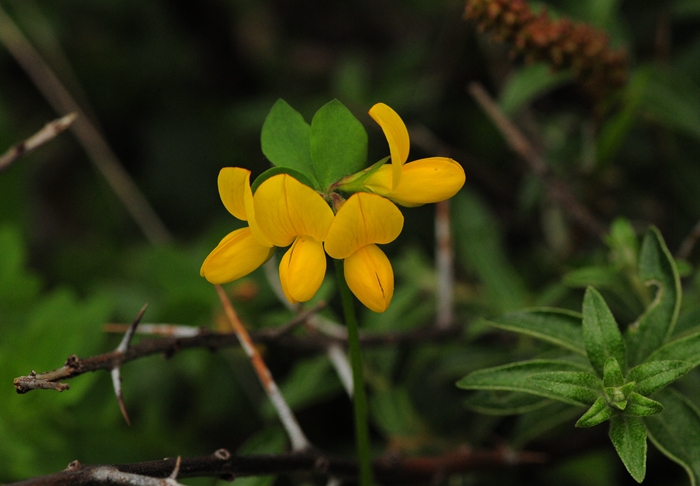- Scientific Name: Lotus corniculatus L.
- Ref: Sp. Pl.:775. 1753
- Synonyms:
- Lotus ambiguus Spreng.
- L. arvensis Pers.
- L. balticus Miniaev
- L. carpetanus Lacaita
- L. caucasicus Kuprian.
- L. corniculatus var. crassifolia Fr.
- L. corniculatus var. kochii Chrtkova
- L. corniculatus var. maritimus Rupr.
- L. komarovii Miniaev
- L. major Scop.
- L. olgae Klokov
- L. ruprechtii Miniaev
- L. tauricus Juz.
- L. zhegulensis Klokov
- English Common Name: common bird’s-foot trefoil, bird’s-foot trefoil, eggs and bacon, birdsfoot deervetch
- Chinese Common Name: 百脉根 bǎimài∙gēn, 牛角花 niújiǎo∙huā
- Japanese Common Name: セイヨウミヤコグサ [西洋都草] seiyōmiyakogusa
- Family: Fabaceae
- Genus: Lotus
- Distribution: Pinus plantations, thickets, scrub, damp meadows, alpine meadows, dry hill pastures, grassy places, rocky slopes, ravines, river valleys, banks, roadsides, abandoned fields, cultivated ground; 400-3400 m. Guizhou, Hubei, Hunan, Sichuan, Taiwan, Tianjin, Xizang, Yunnan [Afghanistan, Bhutan, India, Japan, Kashmir, Kazakhstan, Korea, Mongolia, Myanmar, Nepal, Pakistan, Russia, Tajikistan, Turkmenistan; E and N Africa, SW Asia, Europe; introduced in Australia (including Tasmania), North, Central, and South America, and Pacific islands (New Zealand)].
- Photo: Mt. Siguniang, Sichuan
Herbs, perennial, 15-80 cm, with a taproot, scattered sparsely white puberulent or glabrescent. Stem cylindric to angular, solid, decumbent or ascending. Leaflets 5, apical 3 obovate to oblanceolate-obovate (lateral 2 oblique), 5-20 × 4-10 mm, papery, basal 2 stipulelike, midrib obscure. Umbels rarely more than 7-flowered; peduncle 3-10 cm; sterile bract with 1-3 leaflets, ± equal to calyx, 5-7 mm. Flowers (9-)10-18 mm. Calyx teeth almost equal in length, narrowly triangular, ± equaling, longer than, or shorter than tube. Corolla yellow or partly or wholly orange-red, often bluish black when dry. Ovary glabrous; ovules 35-40; style 4-6 mm. Legume brown, linear-cylindric, 20-25 × 2-4 mm. Seeds light to dark brown, 1-colored or spotted with violet-black spots or dots, small, ovoid, 1-1.7 mm. Fl. (Jan-)Feb-Oct, fr. (Mar-)Apr-Oct. (Flora of China)
